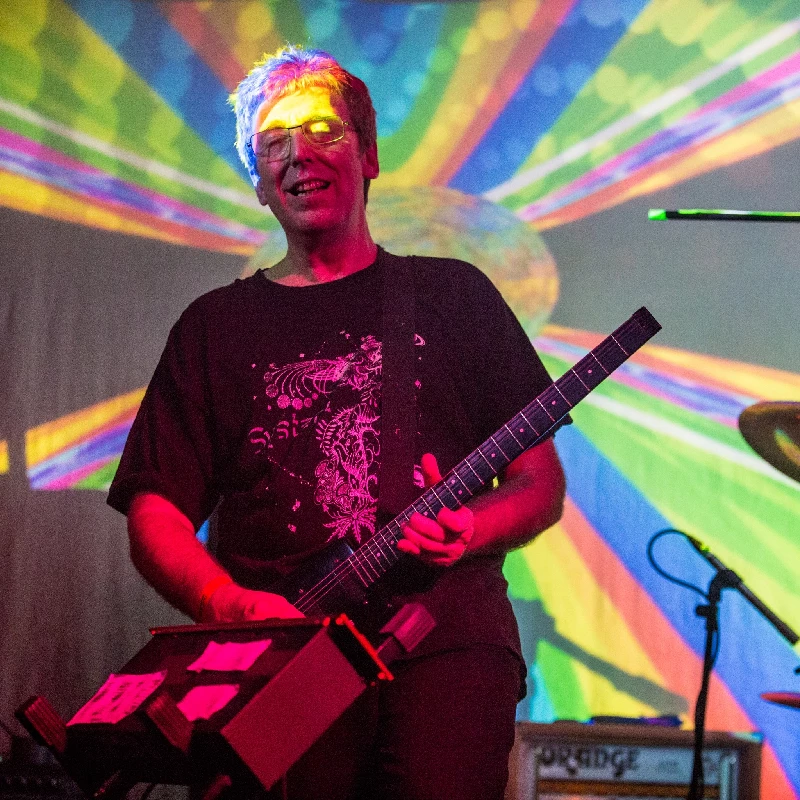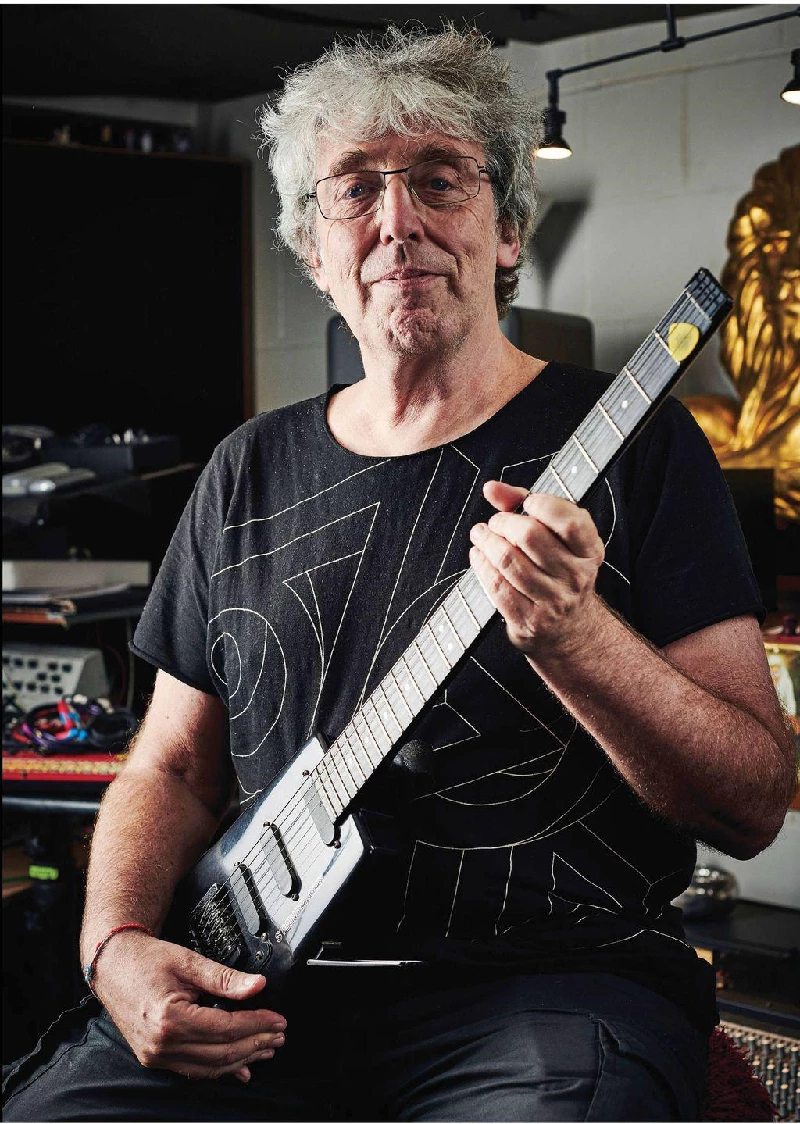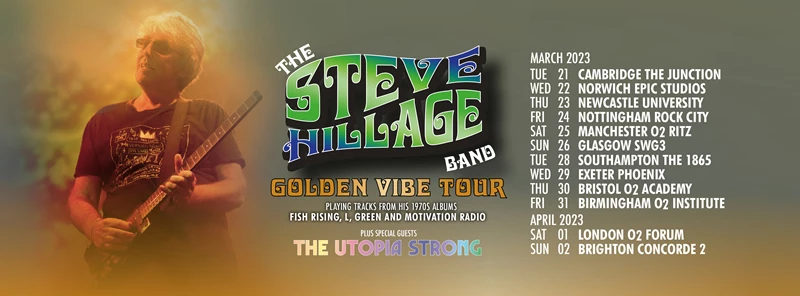Steve Hillage - Interview
by Andrew Twambley and Paul Kimber
published: 26 / 5 / 2023

intro
Guitar legend Steve Hillage talks to Andrew Twambley and Paul Kimber about his lengthy career, working with The Orb and System 7, the recent release of his 1979 Glastonbury set and his forthcoming UK tour.
To an old rocker like myself, Steve Hillage is a brilliant guitarist honed in the late 1960s by The Canterbury Scene, who progressed into the psychedelic and crazy world of Gong, and, thereafter, matured with The Steve Hillage Band in the mid-1970s, where he produced a series of memorable studio albums such as ‘Fish Rising’ and ‘Motivation Radio’. When I mentioned Steve Hillage to my younger and dance-obsessed business partner Paul Kimber, he said, “I’ve never heard of that lot, but I know Steve Hillage from System 7 and The Orb, who I ‘ve been crazy about since university.” So, we interviewed together two very different versions of Steve Hillage, both of which proved equally fascinating. ANDREW TWAMBLEY: You have recently released ‘The Glastonbury Experience’. You’re an artist with a massive legacy in music that goes back over fifty years or so. Why have you suddenly released a 1979 live album? STEVE HILLAGE: We have released quite a few live albums over the last couple of decades, starting with ‘Live at Deeply Vale’ from 1978. It was a pretty big project and it did very well. It sold out, and that just showed me that there was quite a demand for our recordings. After that I went through my huge tape archives and found a load of other things, hence we are releasing some more. AT: I love ‘Radio’ and ‘Glorious Om Riff’ in particular from ‘ The Glastonbury Experience’ but what strikes me about the whole album is it felt like I was right there in the mosh pit in the 1970s. It just felt like I was back there in the old days. Unlike some of these live recordings you hear today, which sound like a studio album with clapping at the beginning and the end. How did you get it so sound so live and authentic? SH: From 1977 onwards, until we stopped at the end of 1979, our live sound engineer recorded the output at the front of house mixed on to cassette. It was called a “mix tape”, and that where all these recordings come from. They did need a lot of attention to make them sound good and that’s where my producer skills come into play. But they are completely live recordings, so it not possible to do any over dubbing or fixin. It is just the way it is, warts and all. AT: You were a major influence in the Glastonbury dance scene, weren’t you? How did that come about? SH: That 1979 gig was actually somewhat traumatic for me. I was involved in organising the Glastonbury Festival at the time. It was the first festival that actually charged for tickets, believe it or not! We were overrunning and we got cut off at the end. That’s why the last track on the CD you can only hear the intro. Michael Eavis got onto the stage and grabbed me and pushed me off. This was in front of 12,000 people and I was rather upset. I didn’t actually listen to the recording of that gig for thirty or forty years because it was painful memories for me. I didn’t want to do anything with it until I happened to hear that someone in the Gong Appreciation Society had a bootleg of it. It was not the full gig, but part of it. I listened to it and I thought, “Wow, that’s really good playing.” Then I ended up checking the tapes and I realised it was a really great performance, a fantastic gusto of energy. I think it was because I was trying to hurry and get it all in before the shut off point of the gig. As far as the music is concerned, I think it is fantastic and I was happy to put it out and the painful memories have subsided. Fast forward to 1993, and there was a whole bunch of people on the dance scene that I was getting embedded in with by that time with System 7, who wanted Glastonbury to make an official dance stage. They knew I had a relationship with Michael Eavis from before, even if they didn’t quite know about my traumas. They asked if I could speak to Michael about this and I thought, “Well, I could write a letter to Michael to make my peace with him after the 1979 trauma, and then maybe I can bend his ear about doing an official dance stage”. So, I sent him this letter in 1994 .and I got a reply, and he said “Yes” and then it happened from there. AT: I wanted to know about your mantra and how it influences your sound. My wife, who is into yoga and meditation, has tried to explain it to me but I still don’t seem to get the musical aspect of it. It has been quite important in your development of music. hasn’t it? SH: Yes. It’s something that I grew up with. My parents had a quite a few problems. and I was left on my own quite a lot. I was used to being on my own. so that’s when I became fascinated in spiritual things. I was interested in things like ghosts and the occult from a really early age. As I developed into becoming a musician, I was looking for a way to combine music and spirituality, and then when I eventually joined Gong Daevid Allen was a specialist in that. He was my teacher in a way and it was the perfect sort of group for me to be in to do that. So, those three years that I was in Gong were really the absolute formative period, and it just continued from there really. AT: You were involved in the seminal ‘Tubular Bells’ live recordings. How did they come about? SH: That was the launch event for The Queen Elizabeth Hall in ’73. At that point nobody knew that ‘Tubular Bells’ was going to be such a big success. I had been aware of this project for quite a while because when I played with Kevin Ayres, before I joined Gong, I was in many ways a replacement of his previous guitarist, Mike Oldfield, who had left to make this new type album. We didn’t know that it was going to be called ‘Tubular Bells’, just that it was Mike Oldfield’s solo album. In fact when I did my first sessions with Gong at the Manor in Oxfordshire, Mike was finishing off with Tom Newman, who was the in-house producer there. and he was coming in the night after we had finished on the downtime, so we were aware of this project as it was being put together. As I said, no one knew it was going to be a.world beater. It was very much Richard Branson’s belief that drove this, which is something that I find quite admirable. Richard wanted to do a launch gig, and he pulled together and recruited a large bunch of musicians including Mick Taylor from The Rolling Stones, Kevin Ayres, Viv Stanshall and he asked me to be part of it. Viv was hilarious particularly because when it came to the bit where he announces all the instruments he kept falling asleep [Laughs]. In the front row of the audience, people had to wake him up and he scuttled onto to stage and grabbed a mic and would introduce everything all wrong. It was just so funny. I don’t know how we kept it together. That gig was amazing because we started off not knowing how it would work out and by the end we got such an amazing reaction from the crowd that everybody knew that this record was going to be a monster. It was a really life-changing event. AT: Have you still got that epic woolly hat? SH: Ha, I’ve got a whole drawer of woolly hats but I’m not wearing them at the moment. AT: You will need to when you come up north on your new tour! My last question before I handover to Paul. You’re touring again in March with the ‘Golden Vibe’ tour. What kind of music will you be playing on this tour? What version of Hillage will it be. Who will we meet? SH: It is very clearly defined. We are playing material mostly from ‘Fish Rising’, ‘Green’ and ‘Motivation Radio’ with a few little extra surprises. I still love that stuff. I love all we do with System 7. That is still the main thing that I do now but I love the music we did in the 70s. I want to keep it alive. I enjoy playing it. It’s difficult to play but I can still do it. AT: Unlike some of the music of that era it doesn’t sound dated when you listen to it now, which is probably why it still lives. That’s me done for now, so over to Paul. PAUL KIMBER: I know you from System 7 really. I’ve seen System 7 many times over the years and I listened to your stuff to death in the early to mid 1990s when I was at university. What started you going into techno dance music as opposed to the guitar-based music that you started with? SH: Basically I was always interested in electronic music right from the early beginning with Walter Carlos, Terry Riley and Rainbow Killers. and I was a big fan of Tonto’s Expanding Head Band and I ended getting them to produce my ‘Motivation Radio’ album. I think that’s where it all started. You may have noticed there are a lot of sevens on the ‘Motivation Radio’ album. Even the catalogue number is V2777 and there the tarot card number 7, the seven UFOs in the sky, so I would say System 7 dates from around that time. I’ll tell you about another incident which got me going. We were touring just after the ‘Green’ album in ‘78 and we were doing a show in Plymouth. It was in a large club. and on before us was a DJ playing an advance copy of ‘The Man Machine’ by Kraftwerk, and all the people were dancing and I was absolutely gobsmacked. I thought “What?” because normally at that time German electronic music was all psychedelic stuff that people called ‘Krautrock’. It was the sort of thing you used to sit crossed legged on the floor with a massive joint and headphones. It was this abstract sound pumping out at these amazing frequencies, and I had an eureka moment and thought, “Jesus/ this going to be enormous.” I stopped touring with my band at the end of the 1970s due to total burnout and I got very much involved in record production, but at the back of my mind I was thinking, “No, I’m going to do some more artistic stuff again” and my music gradually changed. Then the Acid House explosion came in ’87, ’88. and it was irresistible to me. We were propelled into the electronic dance era. PK: You’ve done quite a lot of remixes of System 7. Do you have any criteria that you apply when you decide or not decide to do a remix with somebody? SH: It is like a form of long distance collaboration really. I like it. One of the things that’s great about the dance music scene is that it is very much to do with collaboration and you do tracks with other people. It is great to know what someone will do with a track. I mean you can’t believe how excited we were when we first heard the remix that Richie Haughton had sent us of ‘Alphawave'. I listened to it for the first time and talk about hairs standing up on the back of my neck [Laughs]. It was amazing. So, at the moment we do remixes for other people and our main criteria for that is can we use our remix on our album? So if people say “yes” then generally we work something out as a nice friendly arrangement for doing the remix. That’s the main thing that drives it now. We’ve got some nice tracks out of it. That’s our current way of doing it. PK: One of my favourite albums in the 1990s, and certainly in university, was The Orb’s ‘UFOrb’ and especially ‘Blue Room’. I must have played ‘Blue Room’ a thousand times when I was at university, especially the 45 minute extended version. SH: A wonderful track, a wonderful track. PK: How are you involved in The Orb, I can never tell if you are officially part of The Orb or whether you sort of just dip in and out. SH: At one point they wanted us to become permanent members but we wanted to focus on System 7 and retain that identity. So. it was a partner project basically. We worked on all their tracks and worked on System 7 tracks often at the same time. This relationship is maintained to this day. Obviously at the beginning, when System 7 and The Orb started out we did a lot of stuff together. and ‘Blue Room’ is one of the peak moments. We actually started that off in our apartment in London. AT: It’s my turn again for a kind of finale. I realise we are near the end of our time now but I’ve got one very important. career-defining question for you. SH: Go on! I’m terrified [laughs]. PB: You’ve reached the pinnacle of your career with your solo work and Gong,. You’ve taken it further with some inspirational work for System 7...but looking through your Wikipedia page and your own page, there is something that’s missing and that is ‘Rocket Man’ with William Shatner. What was that all about? SH: I’ve had a long term relationship with an American record label called Cleopatra. They’ve released some of my stuff and they licensed System 7 for several albums. I also do some production work for them and organise tracks for them and they came to me one day and said, “We’ve got a great idea. We want you to play on this album by William Shatner/Captain Kirk called ‘Rocket Man’ and I said “Why not?” I gave it a blast and that’s what happened. AT: Did you ever actually meet him or was it from afar? SH: No, it was all done by remote. He was over there and I was over here, .and I recorded my guitar parts in my own studio and sent them over and they liked what I did AT: Have you listened to the rest of the album? SH: I did actually, quite a long time ago, I can’t remember it very much now but I did listen to it (Laughs). I’m really happy to have done it and I think its great. AT: Thank you.
Band Links:-
http://www.stevehillage.com/https://www.facebook.com/stevehillageband/
https://twitter.com/hillagesteve
Play in YouTube:-
Picture Gallery:-


most viewed articles
current edition
Carl Ewens - David Bowie 1964 to 1982 On Track: Every Album, Every SongArmory Show - Interview with Richard Jobson
John McKay - Interview
Colin Blunstone - Thalia Hall, Chicago, 16/7/2025
Billie Eilish - O2 Arena, London, 10/7/2025
Bathers - Photoscapes 1
Visor Fest - Valencia, Spain, 26/9/2025...27/9/2025
Loft - Interview
Sir Tim Rice - Interview
Robert Forster - Interview
previous editions
Manic Street Preachers - (Gig of a Lifetime) Millennium Stadium, Cardiff, December 1999Heavenly - P.U.N.K. Girl EP
Beautiful South - Ten Songs That Made Me Love...
Oasis - Oasis, Earl's Court, London, 1995
Peter Perrett - In Dreams Begin Responsibilities Interview Part One
Boomtown Rats - Ten Songs That Made Me Love....
Coldplay - Wembley Arena. London, 16/8/2022
Prolapse - Interview
Pixies - Ten Songs That Made Me Love...
Trudie Myerscough-Harris - Interview
most viewed reviews
current edition
Davey Woodward - Mumbo in the JumboSick Man of Europe - The Sick Man of Europe
Lucy Spraggan - Other Sides of the Moon
Amy Macdonald - Is This What You've Been Waiting For?
Phew, Erika Kobayashi,, Dieter Moebius - Radium Girls
Bush - I Beat Loneliness
Suzanne Vega - Flying With Angels
Alice Cooper - The Revenge of Alice Cooper
Cynthia Erivo - I Forgive You
Blueboy - 2
Pennyblackmusic Regular Contributors
Adrian Janes
Amanda J. Window
Andrew Twambley
Anthony Dhanendran
Benjamin Howarth
Cila Warncke
Daniel Cressey
Darren Aston
Dastardly
Dave Goodwin
Denzil Watson
Dominic B. Simpson
Eoghan Lyng
Fiona Hutchings
Harry Sherriff
Helen Tipping
Jamie Rowland
John Clarkson
Julie Cruickshank
Kimberly Bright
Lisa Torem
Maarten Schiethart